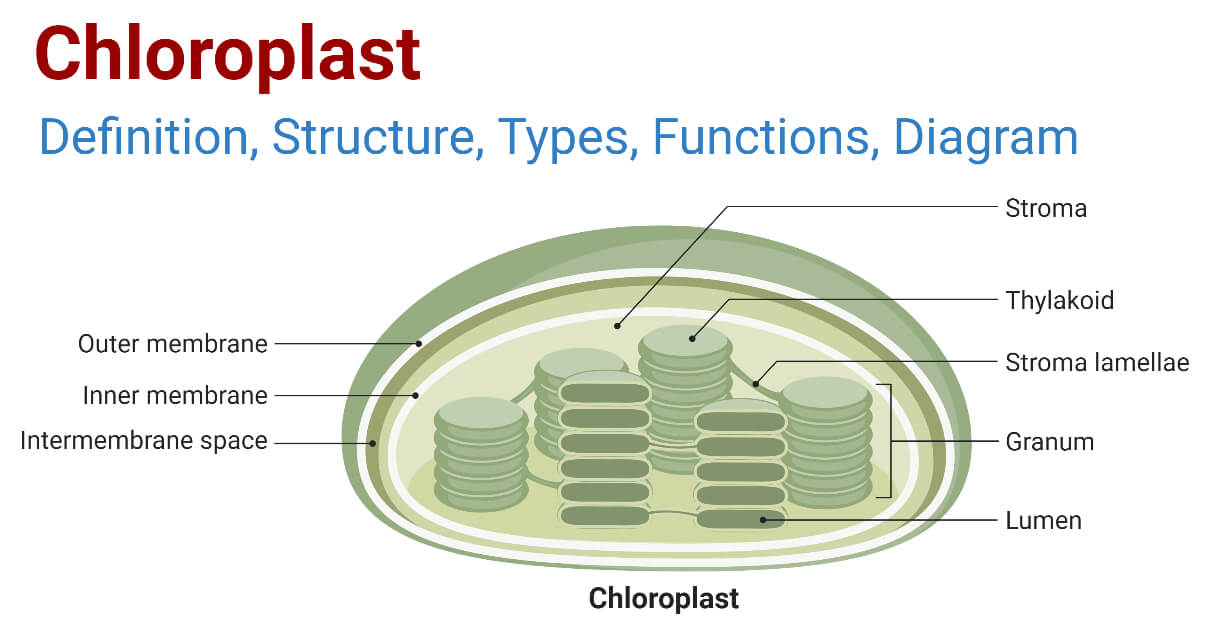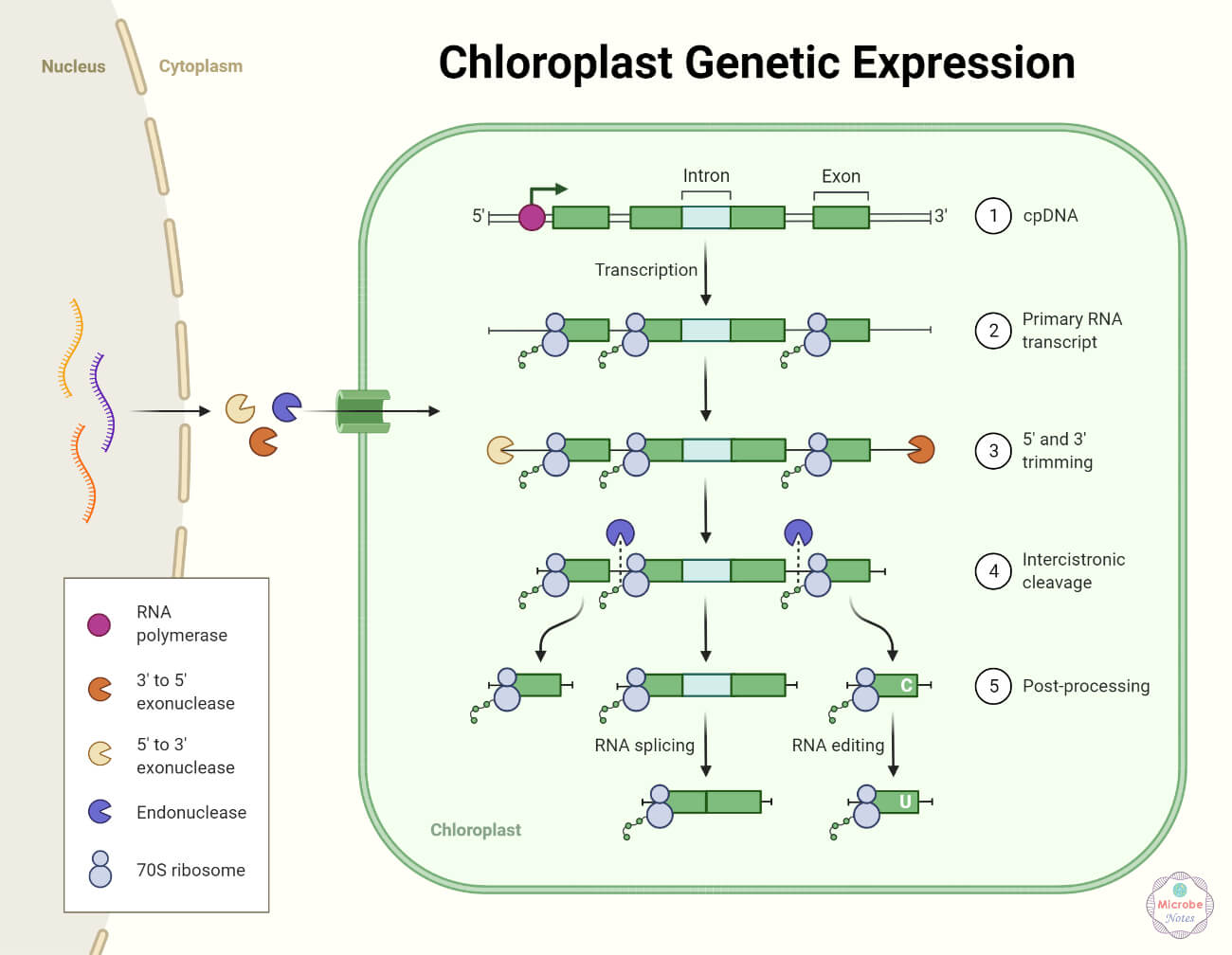- Chloroplast is an organelle found in all photosynthetic cells of plants.
- These are also found in some protists, for example,Euglena.
- Chloroplasts are the most common type of plastid.
- These are absent in those plants which are not exposed to light.
- Chloroplast is derived from the Greek word “chloros”. It means green, and plastic, which means form.
- Chloroplasts were first observed by Antony Von Leeuwehoek in 1679.
- The term chloroplast was given by Schimper (1883 A.D.)
- Chloroplast originated from proplastids found in the growing region of plants and are surrounded by two membranes.
- When its size increases (up to 1µm) the inner membrane invaginates to form vesicles in the presence of sunlight.
- They are very important for plants, becausephotosynthesisby which complex organic food is manufactured, takes place in them.
- In the cytoplasm of plant cells, the chloroplast is well distributed homogeneously. however, it is concentrated around the nucleus.
- Similarly, in certain cells, it is present just beneath the plasma membrane.
- They have a green color which helps to distinguish them from other types of plastid. The green color is produced from the presence of two pigments, chlorophyll a and chlorophyll b.
- Other types of plastids such as leucoplast and the chromoplast do not carry out photosynthesis and have low concentrations of chlorophyll.
- 其他色素,类胡萝卜素也存在于chloroplast which serve as accessory pigments. Carotenoid trapping solar energy and passing it to chlorophyll.
- Like mitochondria, chloroplast has its own extra-cellular DNA, which is thought to be inherited from the ancestor a photosynthetic cyanobacterium that was engulfed by an early eukaryotic cell.
- They also produced lipids and proteins essential for the production of chloroplast membrane.
- Chloroplast is moved around within plant cells, circulates, and is occasionally compressed in two to reproduce.
Chloroplast Morphology
- Its size and shape vary from species to species. In higher plants chloroplast are generally biconvex or planoconvex.
- However, in different plant cells, it may have various shapes such as filamentous, saucer, ovoid, discoid, spheroid, star-like girdle-shaped, spiral ribbon-like, reticulate, or cup-shaped.
- The size of the chloroplast is generally measured at about 5-10 µm in diameter and 2-3 µm in thickness.
- The chloroplast of cells of polyploid and shade plants are comparatively larger than the chloroplast of cells of diploid and sun plants.
- From cell to cell, chloroplast’s numbers differ from one to another.
- It depends on the physiological state of the cell also. For example,Chlamydomonashas only one chloroplast however 1-16 chloroplast inSpirogyra.
- According to a calculation,Ricinus communisleaf contains about 400,000 chloroplasts per square millimeter of surface area.
- The number of chloroplast gets increased by division when it’s inadequate in number.
- Similarly, degeneration takes place when it’s excessive in number.
Types of pigments
- Chlorophyll
- Chlorophyll是一个绿色的色素位于叶绿体。More specifically, it is found in the thylakoid membranes.
- The chlorophyll consists of 75% of chlorophyll a and 25% of chlorophyll b.
- The chlorophyll absorbs energy from sunlight and the synthesis of food molecules in the chloroplast.
- Carotenoids
- Carotenoids are the pigments present in chlorophylls which are located in the thylakoid membrane. Pigments like yellow and orange are present in it.
- Carotenoids are related to vitamin A.
- They are important because they can absorb a certain wavelength of light that can not be absorbed by chlorophylls.
- Carotenoids are involved in a function known as photoprotection.
- Xanthophylls
- The carotenoids are carotenes and xanthophylls. Xanthophylls are present in the brown and green algae.
- Phycobilin
- Phycobilin is found only in red algae andCyanobacteria.It has a relatively narrow distribution.
- Phycoerythrin and phycocyanin are other accessory pigments belonging to this family.
- Phycoerythrin makes red algae commonly red and phycocyanin causes theCyanobacteriato appear blue-green.
Chloroplast Structure
A chloroplast consists of three main components.
Envelope
- The chloroplasts are bounded by an envelope, which consists of a double membrane with outer and inner lipoprotein layers. Space or gap between two layers is known as intermembrane space.
- The molecules get exchanged across the double-membrane envelope. This interchange occurs between the chloroplast and the cytosol.
- The isolated membrane of an envelope of chloroplast has a yellow color because a small number of carotenoids are present in it. However it lacks chlorophyll pigment and cytochromes.
- They contain only 1 to 2 percent of the total protein of chloroplast.
- Glaucophyte algal chloroplast consists of a peptidoglycan layer between the chloroplast membrane.

Stroma
- The major volume of chloroplast consists of a matrix or stroma which surrounds the thylakoids (grana).
- The space between the inner membrane and thylakoid membrane is filled with stroma or matrix which is a colorless, denser, and granular ground substance.
- The stroma mainly consists of protein (more than 50%) and also has 70 ribosomes (plastid ribosomes), circular and naked DNA molecules (0.5%),mRNAandtRNAmolecules,water, minerals, andenzymes. It is the site of the dark reaction of photosynthesis.
- Some structural proteins present in the chloroplast are synthesized by the Ribosomes and DNA of the chloroplast.
- The stroma is the place where CO2fixation occurs. Similarly, fatty acids, sugars, starch, and proteins are also synthesized in it.
- In the stroma, small structure grana (singular granum) and intergrana connecting membranes remain embedded.
- The network of membranous tubules interconnects the grana. It is known as the intergarna or stroma lamellae or frets.
Thylakoids
- The third internal membrane is extensively folded and characterized by the presence of closed disc-shaped (or thylakoids) membranous sacs known as thylakoid membrane.
- Stroma and the outer surface of the thylakoid are in contact with each other.
- Similarly, its inner surface encloses an intrathylakoid space ( i.e third compartment).
- Like the piles of coins, thylakoids are stacked one upon another. It then forms the grana or, they may be unstacked, intergranal, or stromal thylakoids, forming a system of anastomosing tubules that are joined to the grana thylakoids.
- Each granum consists of disc-shaped membranous sacs called thylakoids piled one upon others.
- In the matrix of a chloroplast, approximately 40-80 grana may be present. The number of thylakoids per granum may vary from 1 to 50 or more. For example, there may be single thylakoids (e.g., red alga), triple thylakoids, and multiple thylakoids (e.g., green algae and higher plants).
- In the thylakoid membrane, all the enzymatic components which are essential for photosynthesis are also present.
- They are the site of light reactions.
- Interaction between chlorophyll and other components takes place within the thylakoid membrane.
- The vesicle becomes arranged to form a chain of a large disc which are not connected.
- Fusion of the discs takes place to give rise to thylakoid and stroma lamella.
Semi-autonomous nature of chloroplast
- Like the mitochondria, they are also known as semi-autonomouscell organellesas they got their DNA and complete machinery to synthesize some of the required proteins.
- While some other proteins depend upon nuclearDNAand cytoplasmicribosomes.
- 叶绿体和mitochondriaare the only two organelles having their DNA.

Functions ofChloroplast
- The most fundamental function of chloroplast is photosynthesis. They synthesize food by photosynthesis.
- Light energy is absorbed by chloroplast and converted into chemical energy.
- They produce NADH and oxygen for respiration for all the aerobes by photolysis of water.
- These maintain O2and CO2balance in thebiosphere.
- Chlorophyll tapering solar energy is used for photosynthesis in which ATP is produced.
- Chloroplast reduced the CO2concentration it helps to prevent global warming.
- They store the starch in the proteinaceous bodies called pyrenoids in algal forms.
- The synthesis of fatty acids occurs in the chloroplast of spinach.
- Chloroplast is responsible for natural greenery.
- Carbon and sugar are generated during the Calvin cycle or dark reaction by using CO2obtained from air.
References
- Verma, P. S., & Agrawal, V. K. (2006). Cell Biology, Genetics, Molecular Biology, Evolution & Ecology(First edition). S . Chand and company Ltd.
- Alberts, B. (2004). Essential cell biology. New York, NY: Garland Science Pub.
- Keshari, A.K (2020). A textbook of higher secondary biology. 13th edition. Vidyarthi pustak bhandar, Kathmandu,Nepal.
- https://byjus.com/biology/chloroplasts/
- https://www.britannica.com/science/chloroplast
- https://www.sciencedirect.com/topics/biochemistry-genetics-and-molecular-biology/chloroplast
- https://www.frontiersin.org/research-topics/5623/structure-and-function-of-chloroplasts
- https://www.toppr.com/ask/question/why-do-we-believe-chloroplast-and-mitochondria-to-be-semiautonomous-organelle/
- https://ucmp.berkeley.edu/glossary/gloss3/photosyn/pigments.html

